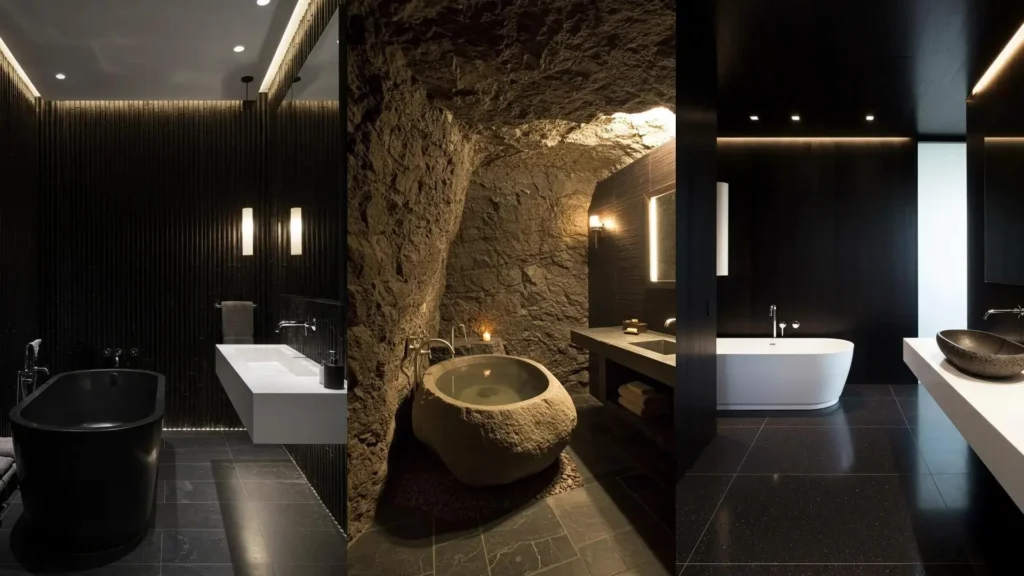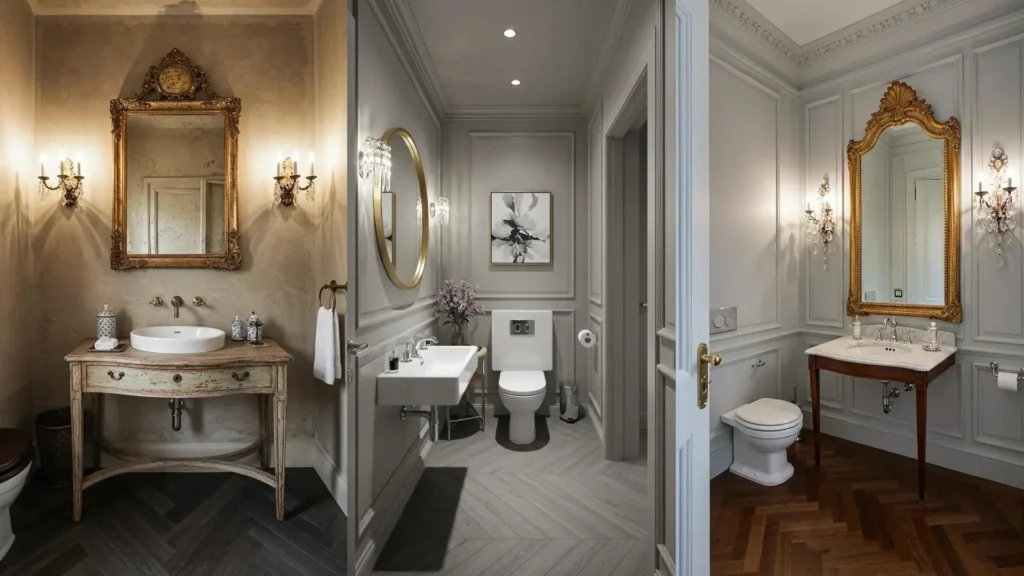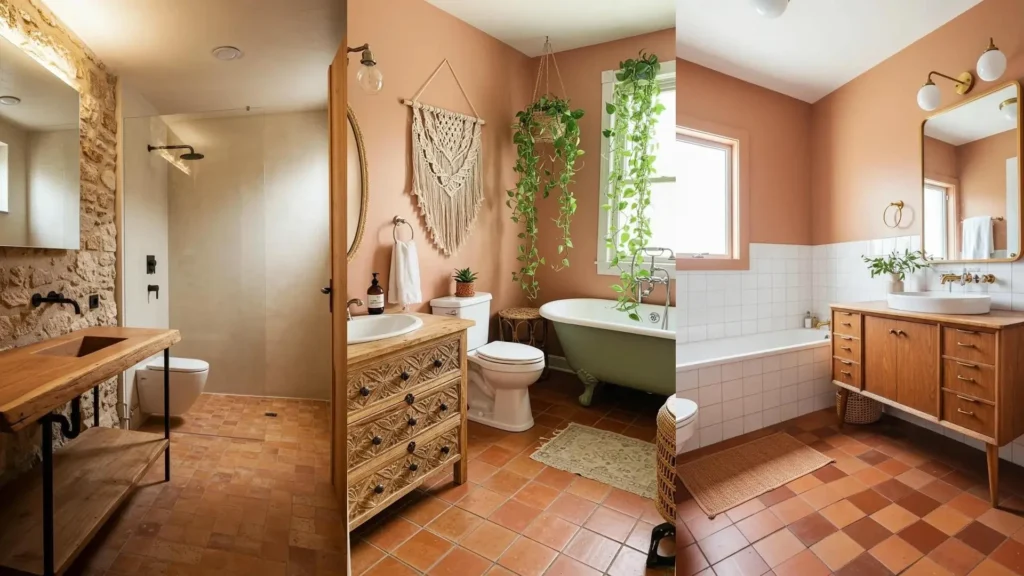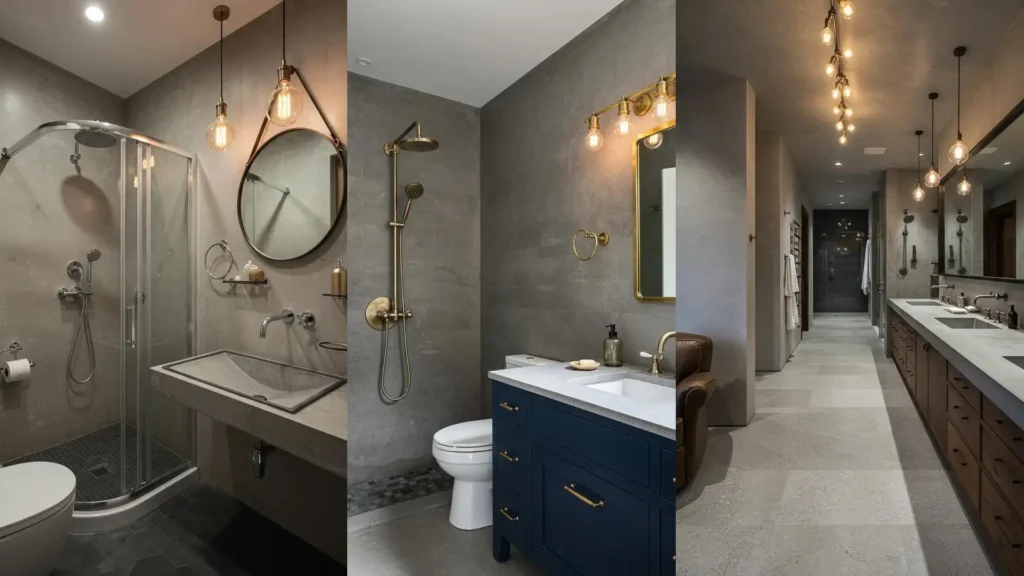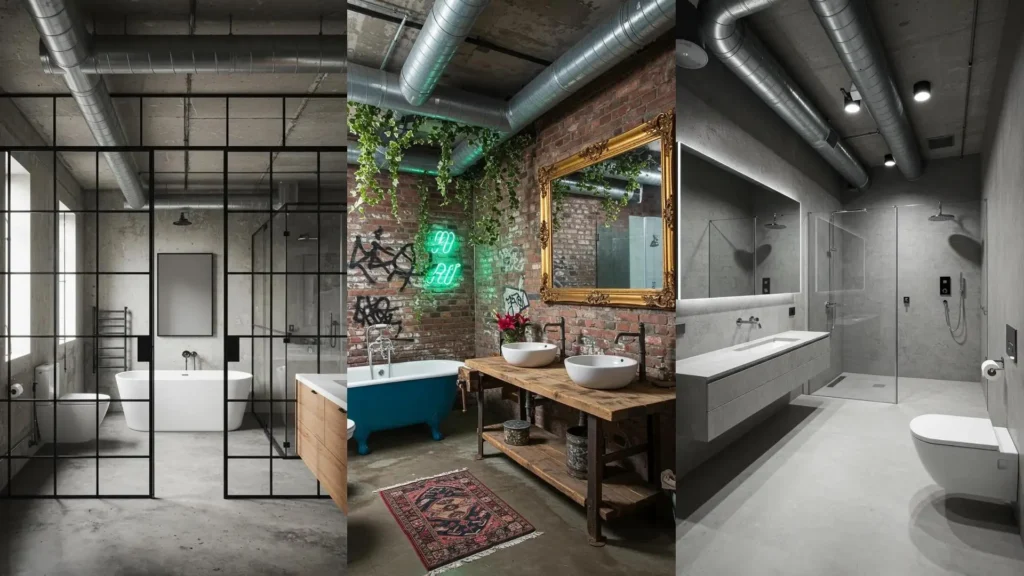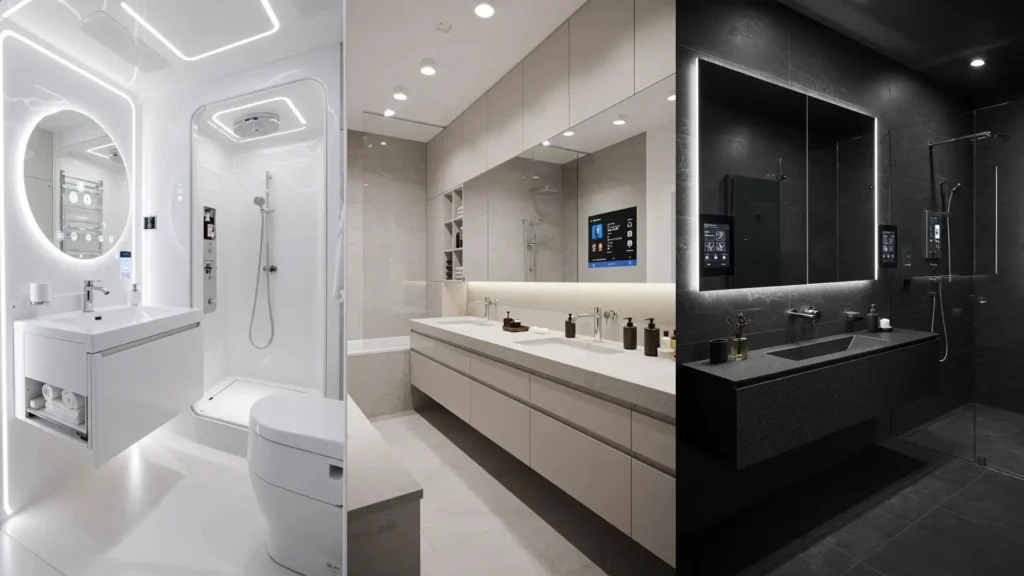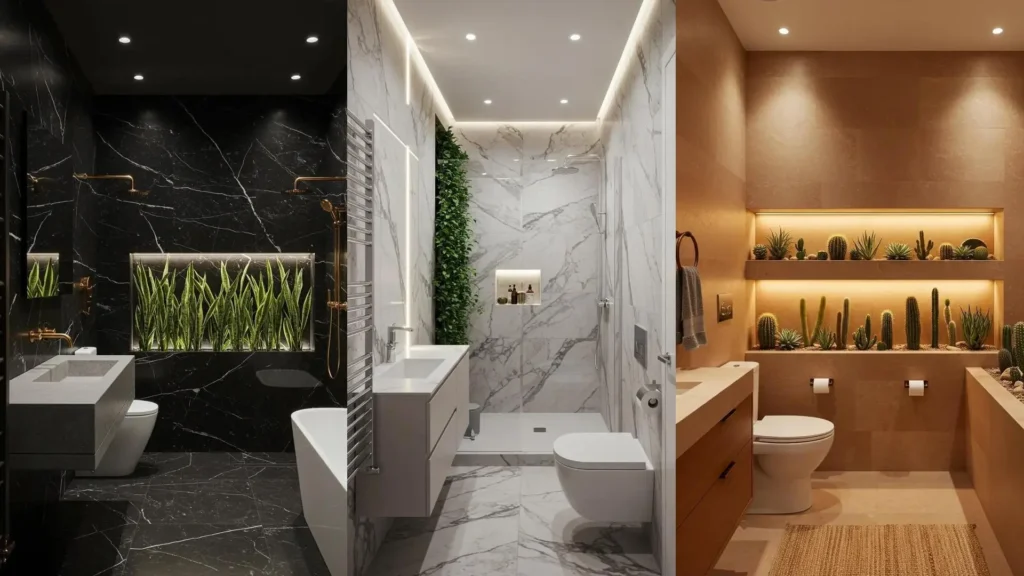Your bathroom is more than just a functional room—it’s the first space you see in the morning and the last one at night.
It holds the potential to be a true sanctuary, a place where you can shed the stress of the day and reconnect with yourself.
Creating that feeling doesn’t require a complete overhaul. It’s about making thoughtful choices with texture, light, and natural materials to design a space that feels calm, intentional, and deeply personal.
Let’s explore how you can bring a sense of Zen-like tranquility into your own home, one beautiful detail at a time.
1. The Window as a Living Mural

Frame a beautiful view with dark, minimal window trim, turning the landscape into the room’s primary artwork.
By keeping the interior palette simple—natural wood, dark slate, and stone—you ensure nothing competes with the scene outside.
A traditional Japanese soaking tub, or ‘ofuro,’ is typically crafted from hinoki wood, prized for its fragrance and durability, but cedar is a wonderful alternative.
Define the bathing area with a bed of smooth river rocks; this adds an organic texture and a practical, slip-resistant surface for a wet zone.
If you lack a forest view, even a small, private courtyard or a window with frosted glass can provide the light and seclusion needed for a tranquil atmosphere.
2. Embrace a Dramatic, Low-Light Ambiance
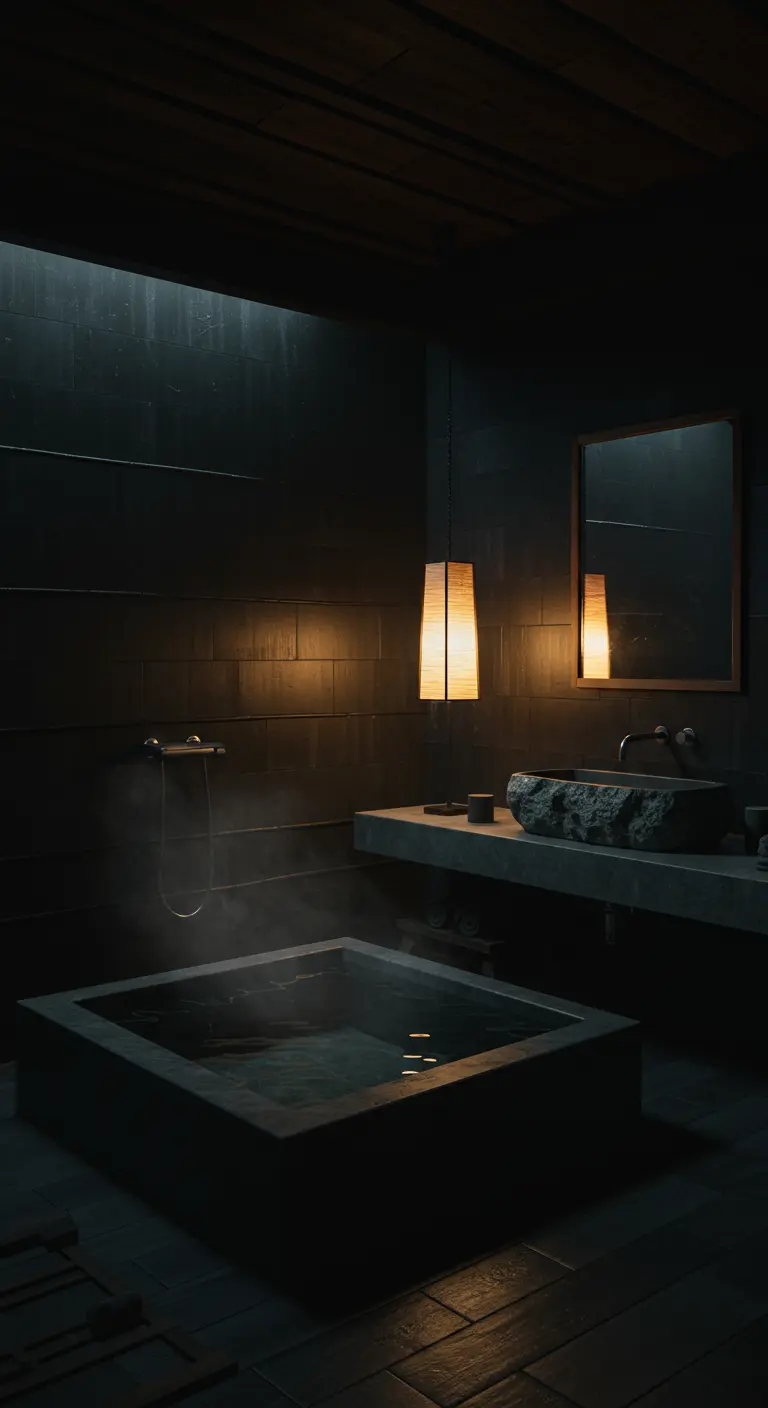
Prove that a bathroom doesn’t need to be bright white to feel restorative.
Create a moody, immersive retreat by using dark, matte-finish tiles on both walls and floors, which absorb light and create a cocooning effect.
Lighting is your most important tool here. Instead of bright overheads, use focused sources like a single pendant over the vanity and low-level wall grazers to highlight texture.
Always install dimmers on every light source to give you complete control over the atmosphere, shifting from functional to deeply serene in an instant.
3. Dissolve the Barrier to Nature

Visually merge your bathroom with the outdoors using a floor-to-ceiling glass wall, which makes the entire room feel larger and more alive.
This design dedicates a small outdoor area to become a private garden view, transforming it into living art.
Achieve a seamless transition by using light wood paneling and similar flooring tones both inside and out.
Even if a full glass wall isn’t feasible, a large picture window positioned over the tub can create the same powerful connection to a curated outdoor space.
4. The Architectural Glow of a Backlit Wall

Introduce a soft, ambient glow by creating a backlit feature wall behind the vanity.
Using panels of a translucent stone like onyx or alabaster creates a diffused, high-end light source that feels both warm and architectural.
This technique provides beautiful, even lighting for the vanity area, eliminating the harsh shadows cast by typical overhead fixtures.
For a more accessible approach, you can achieve a similar effect with frosted glass panels and strategically placed LED light strips.
5. The Quiet Beauty of Reclaimed Textures

Create a rich, sensory experience by celebrating the imperfections of natural, time-worn materials.
An accent wall of reclaimed wood adds immense character and warmth, telling a story that new materials cannot.
Balance the rough texture of the wood with the smooth, cool finish of concrete or plaster walls and the rugged feel of flagstone floors.
This intentional mix of textures—rough, smooth, and rugged—is what gives the space its depth and wabi-sabi soul.
6. Maximize Light in a Narrow Space
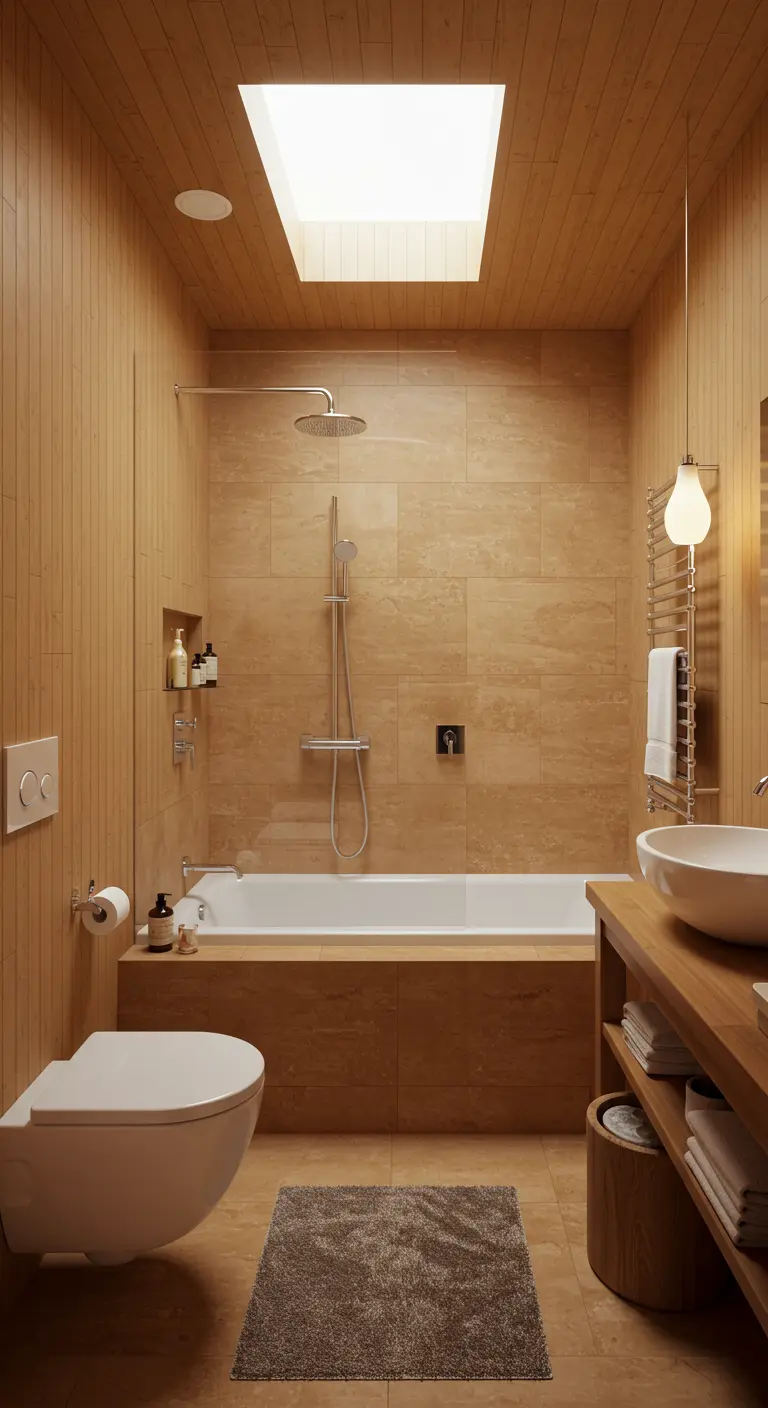
In a bathroom without windows, a skylight is a game-changing element that floods the room with natural light, making it feel instantly larger and more open.
Draw the eye upward by using a consistent material on the walls and tub surround, like this light wood paneling.
This seamless application prevents visual breaks and clutter, which is essential in a compact layout.
Further enhance the sense of space by choosing a wall-mounted toilet, which keeps the floor clear and creates an illusion of a larger footprint.
7. Sculpt with Light and Shadow
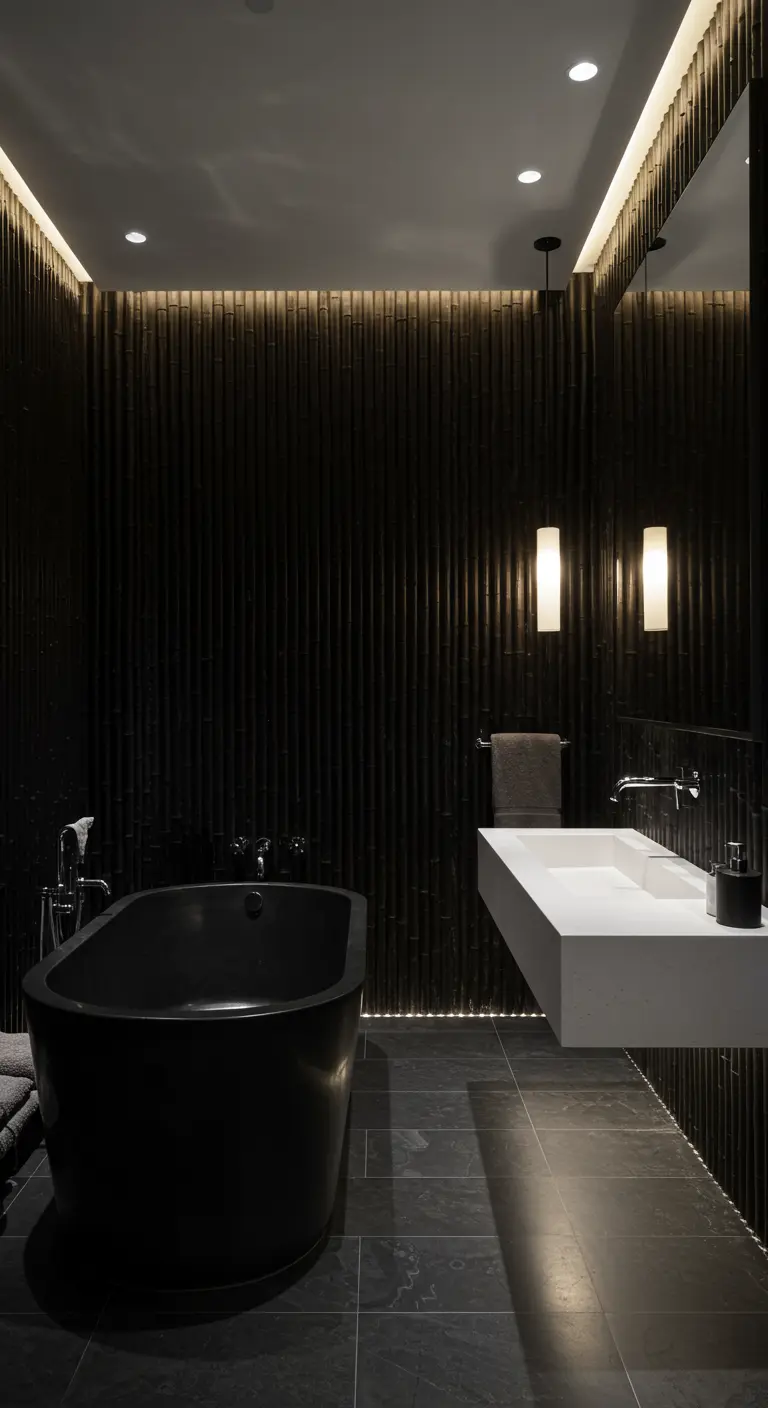
Use lighting as an artistic tool to add depth and drama to a dark, monochrome bathroom.
Cove lighting installed along the ceiling edge washes the textured bamboo walls, highlighting their vertical lines and preventing the dark color from feeling flat or heavy.
Treat key features like sculptures by aiming spotlights directly at the bathtub and vanity.
The floating white vanity provides a sharp, clean contrast that appears to hover, adding to the room’s architectural interest.
8. The Power of a Single, Perfect Circle

Bring a sense of harmony and gentle focus to your bathroom by repeating a simple, soft shape.
A circular skylight, or oculus, creates a celestial focal point, casting a beautiful, moving circle of light that changes throughout the day.
Echo that shape in a round soaking tub, a curved basin, or a circular mirror to create a cohesive and calming visual rhythm.
In such a minimalist zen lounge, a single bonsai tree is all the decor you need to complete the meditative feel.
9. The All-Encompassing Warmth of Wood
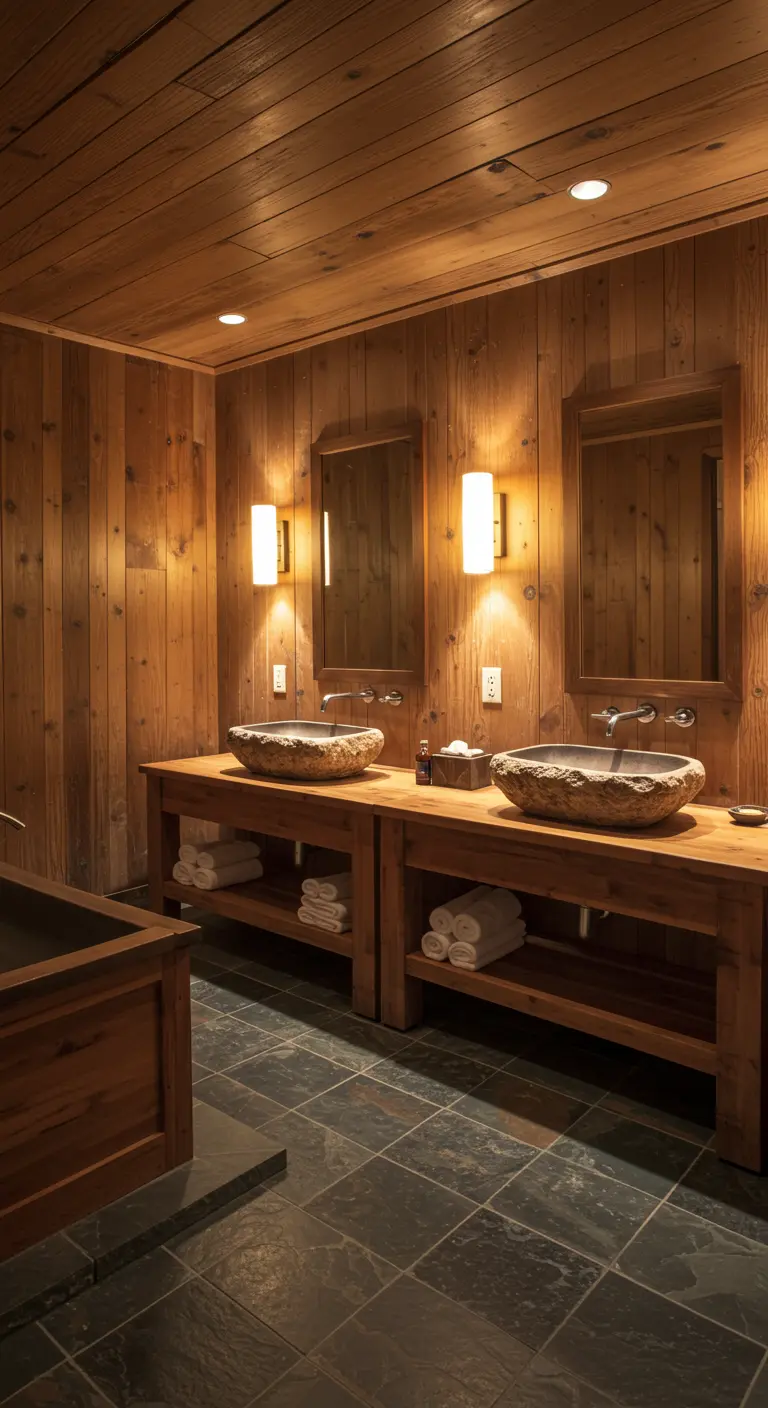
Create a cozy, cabin-like retreat by enveloping the entire room—walls and ceiling—in warm, knotty pine.
This creates a seamless, cocooning effect that feels incredibly comforting and protective.
The key to keeping it from feeling overwhelming is to introduce strong textural contrasts.
A cool, dark slate floor grounds the space, while rough-hewn stone sinks add an earthy, organic element that balances the wood’s warmth.
10. Filtered Light for a Softer Feel
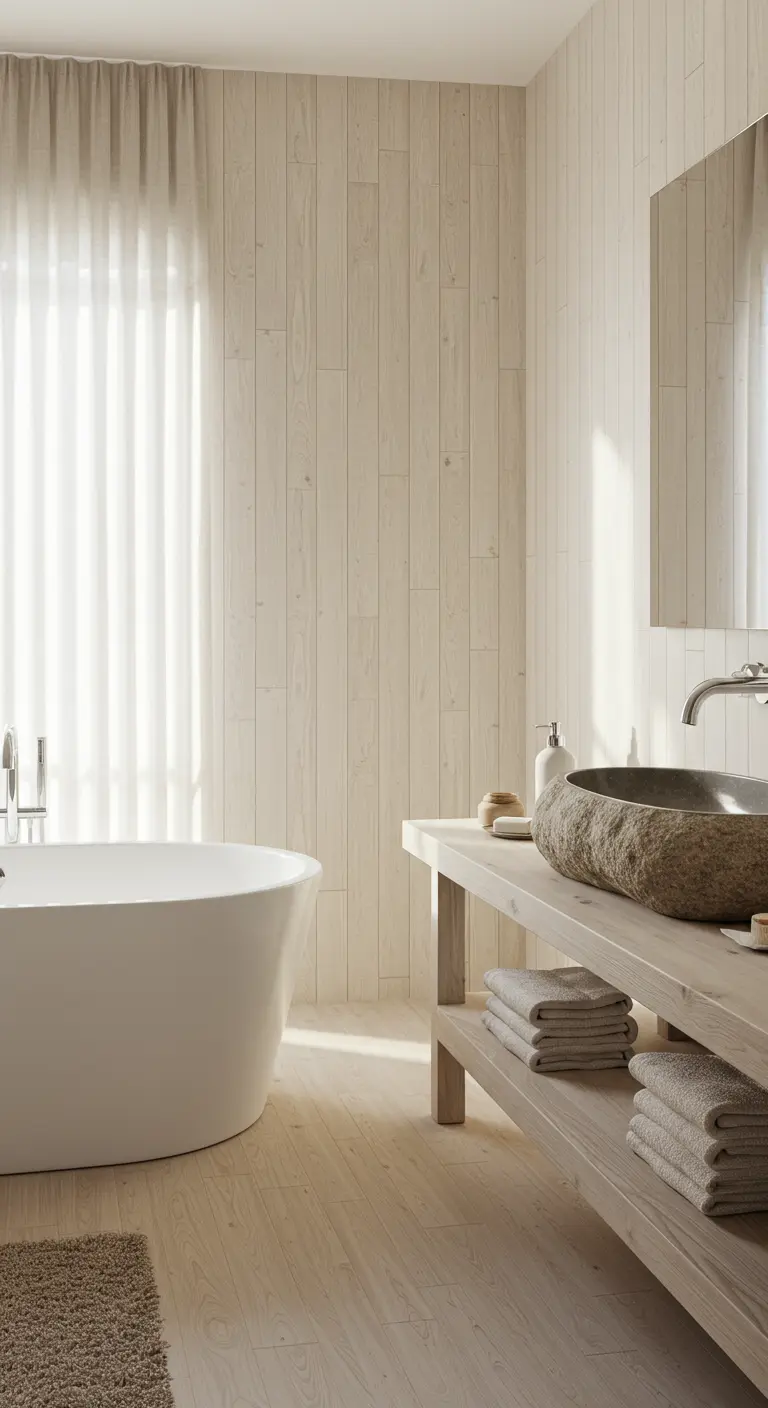
Soften the entire mood of your bathroom by filtering the natural light through a floor-to-ceiling sheer curtain.
This simple addition provides privacy while transforming harsh sunlight into a gentle, ethereal glow that feels calm and forgiving.
Pair this with whitewashed or pale wood paneling, which has a softer presence than raw wood, to enhance the airy, cloud-like atmosphere.
Keep major elements like the tub and vanity in simple, light tones to maintain the uncluttered feel of a serene Scandinavian spa.
11. The Grotto: Bathing as a Primal Experience

For a truly profound statement, design a space that evokes the feeling of a natural cave or grotto.
Using exposed, rough-hewn stone on the walls and ceiling creates an immersive, elemental environment.
A tub carved from a single, massive boulder becomes the undisputed centerpiece, transforming bathing into a primal ritual.
To balance the immense texture of the rock, keep all fixtures sleek and minimal and the floor a simple, dark tile.
12. Follow the Curve for a Natural Flow
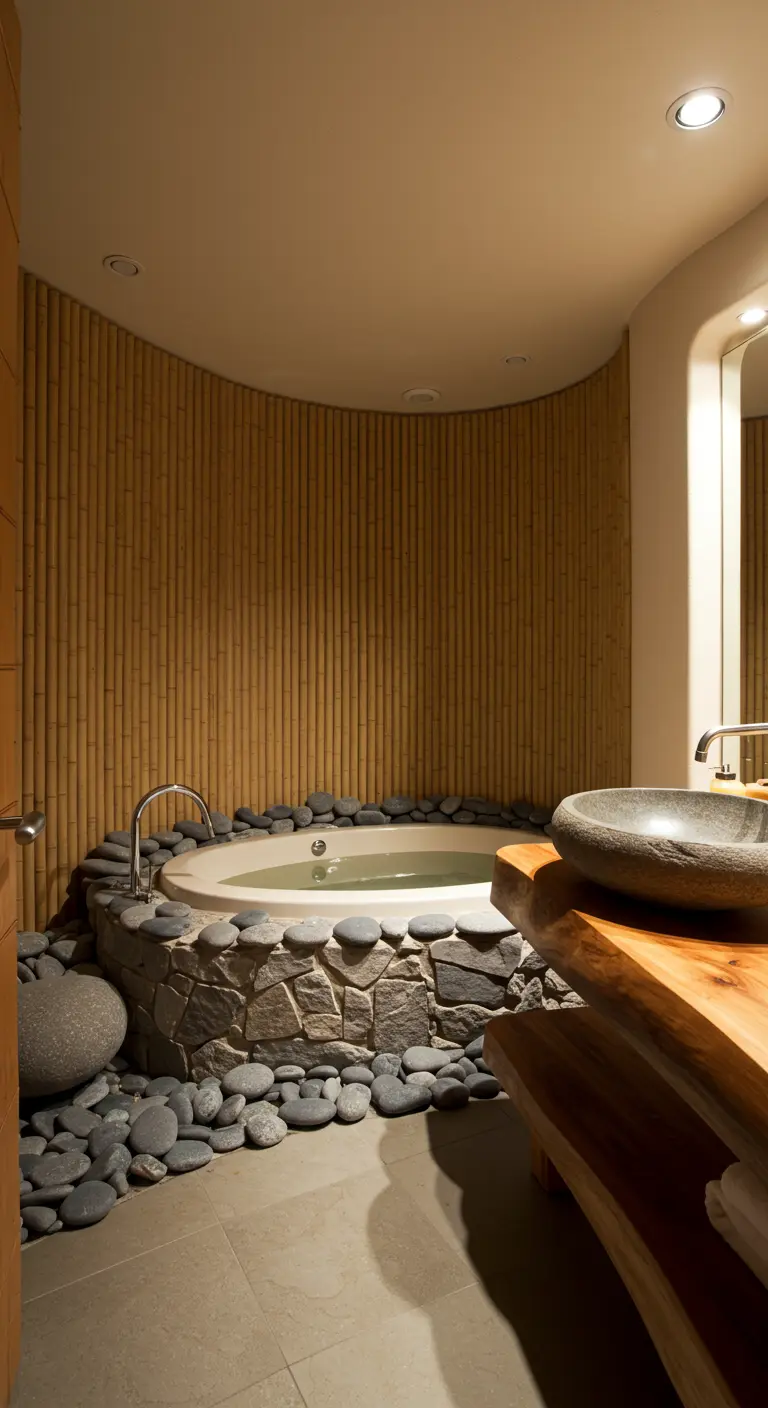
Break free from the standard boxy bathroom by introducing a curved wall, which immediately softens the space and creates a more organic flow.
Emphasize the shape by cladding it in a material with strong vertical lines, like the bamboo poles seen here.
Continue the natural theme by surrounding a built-in tub with large, smooth river stones, blurring the line between architecture and landscape.
A live-edge wood vanity is the perfect finishing touch, with its own unforced, natural contours.
13. Introduce Metal for Unexpected Warmth
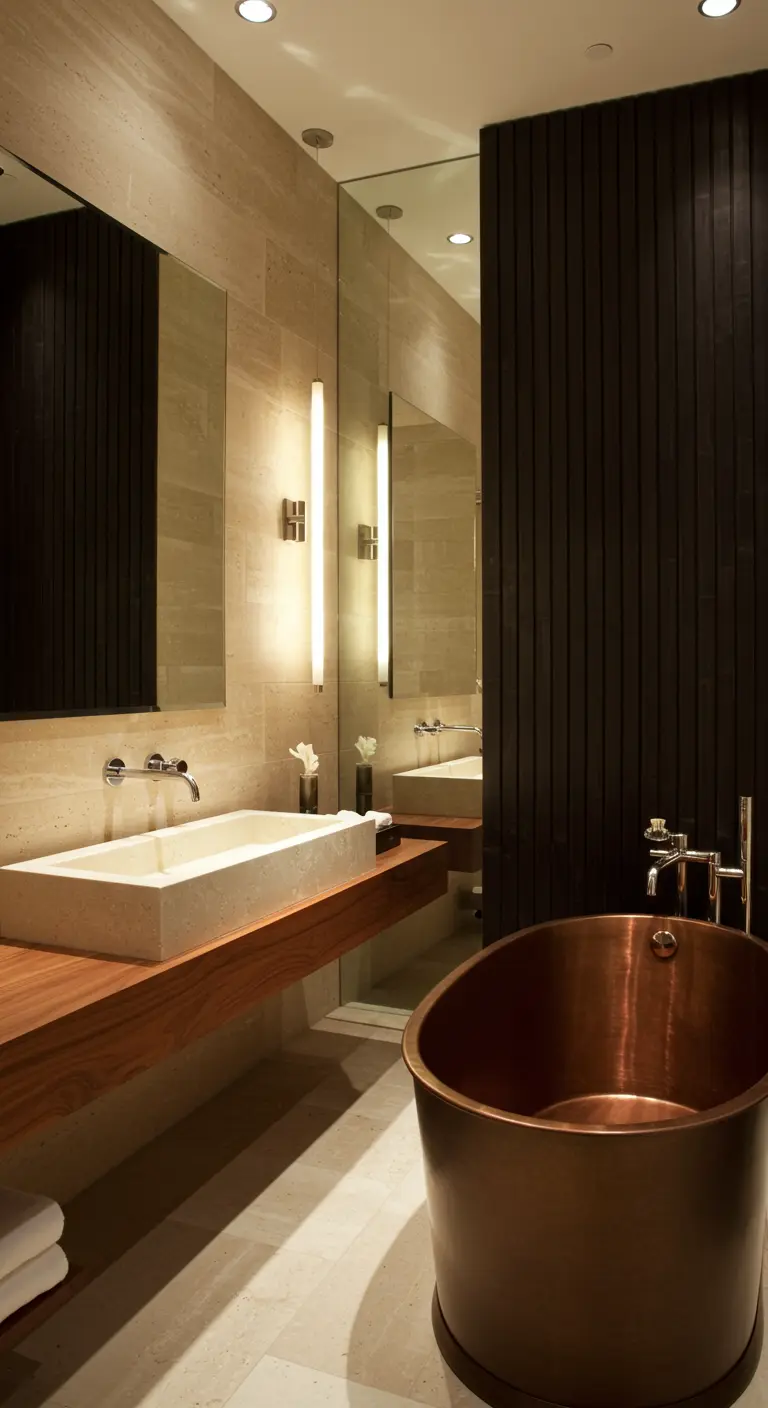
Elevate your design with the unexpected warmth and glow of a statement copper tub.
The polished, rosy sheen of copper provides a luxurious focal point that contrasts beautifully against both dark, ribbed wood and smooth, light-colored stone.
This sophisticated mix of materials—dark wood, pale stone, and polished metal—creates a rich and layered look.
Keep the surrounding elements and fixtures simple to allow the tub’s unique finish to take center stage.
14. Blend Rustic Americana with Zen Simplicity

Don’t be afraid to combine distinct styles to create a space that feels uniquely yours.
This bathroom successfully marries the rugged feel of a log cabin with the serene principles of Japanese design.
The classic clawfoot tub and log walls feel traditional, while the bamboo screen and stone vessel sink introduce a note of Zen tranquility.
The design works because of a shared palette of natural materials and earthy tones, similar to the fusion found in Japandi interiors.
15. The Elegance of Intentional Emptiness

Embrace the Japanese design principle of ‘Ma’—the value and beauty of negative or empty space.
This bathroom achieves its profound sense of calm not through decoration, but through its deliberate absence.
The focus is on a few perfectly chosen elements: the clean form of the tub, the warmth of the wood, and the life of a single plant.
A skylight provides soft, natural light, removing the need for cluttered fixtures. True luxury lies in the quality of the materials and the simplicity of the composition.
16. Create a Living, Breathing Wall

Bring nature indoors in the most dramatic way possible with a vertical garden, or ‘living wall.’
This feature acts as a stunning focal point, purifies the air, and introduces unparalleled texture and vibrancy.
In a bathroom’s humid environment, choose plants that will thrive, such as ferns, pothos, and bromeliads.
While professional systems with built-in irrigation are ideal, you can create a smaller-scale version with a modular wall-mounted planter system.
17. Ground Your Space with a Pebble Floor
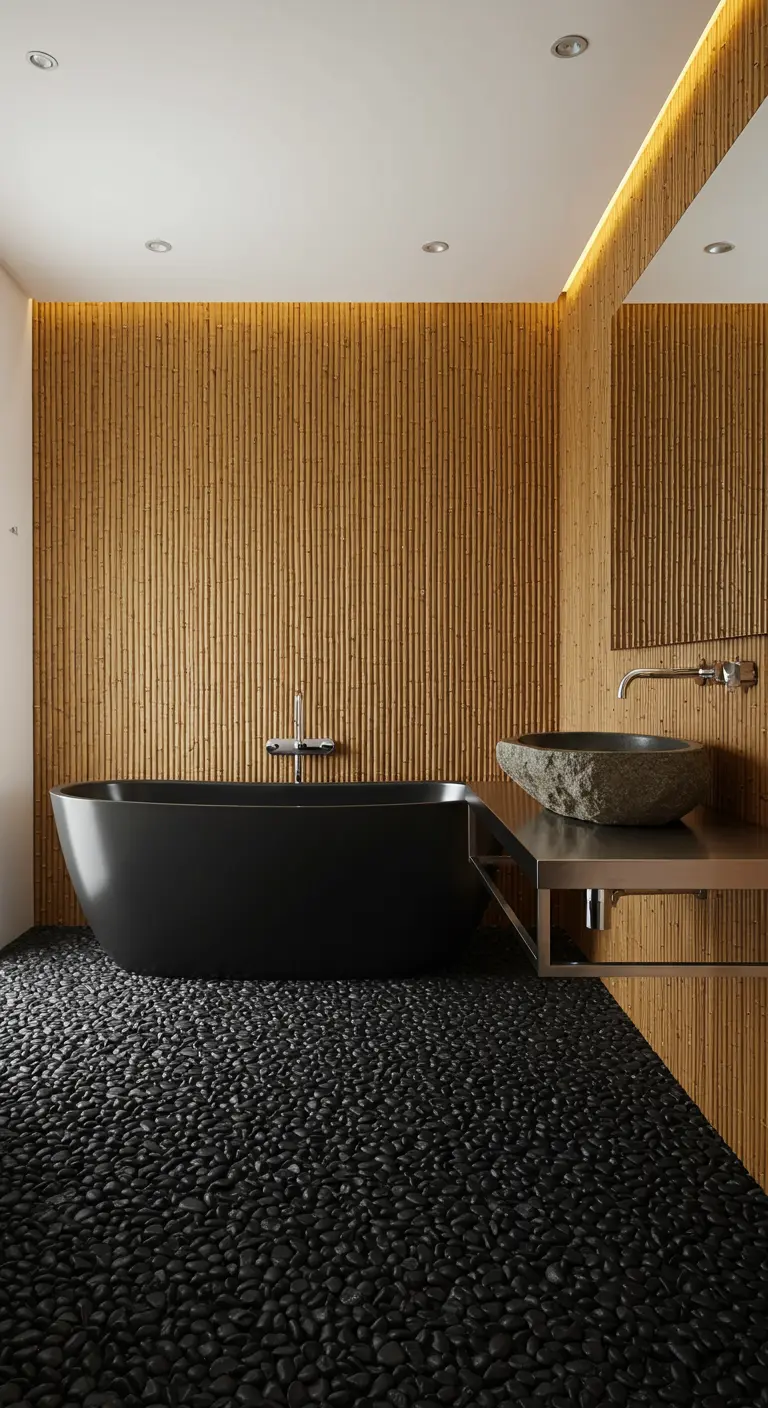
Introduce a powerful, grounding element with a floor made of smooth river rocks.
Walking on the pebble surface provides a gentle massage and evokes the feeling of standing in a natural stream bed.
Here, dark pebbles create a seamless, dramatic surface that unifies the space and provides an organic contrast to the clean, linear bamboo wall panels.
This is an excellent choice for a walk-in shower or a full wet room, adding both texture and slip resistance.
18. The Soft, Translucent Light of a Shoji Screen
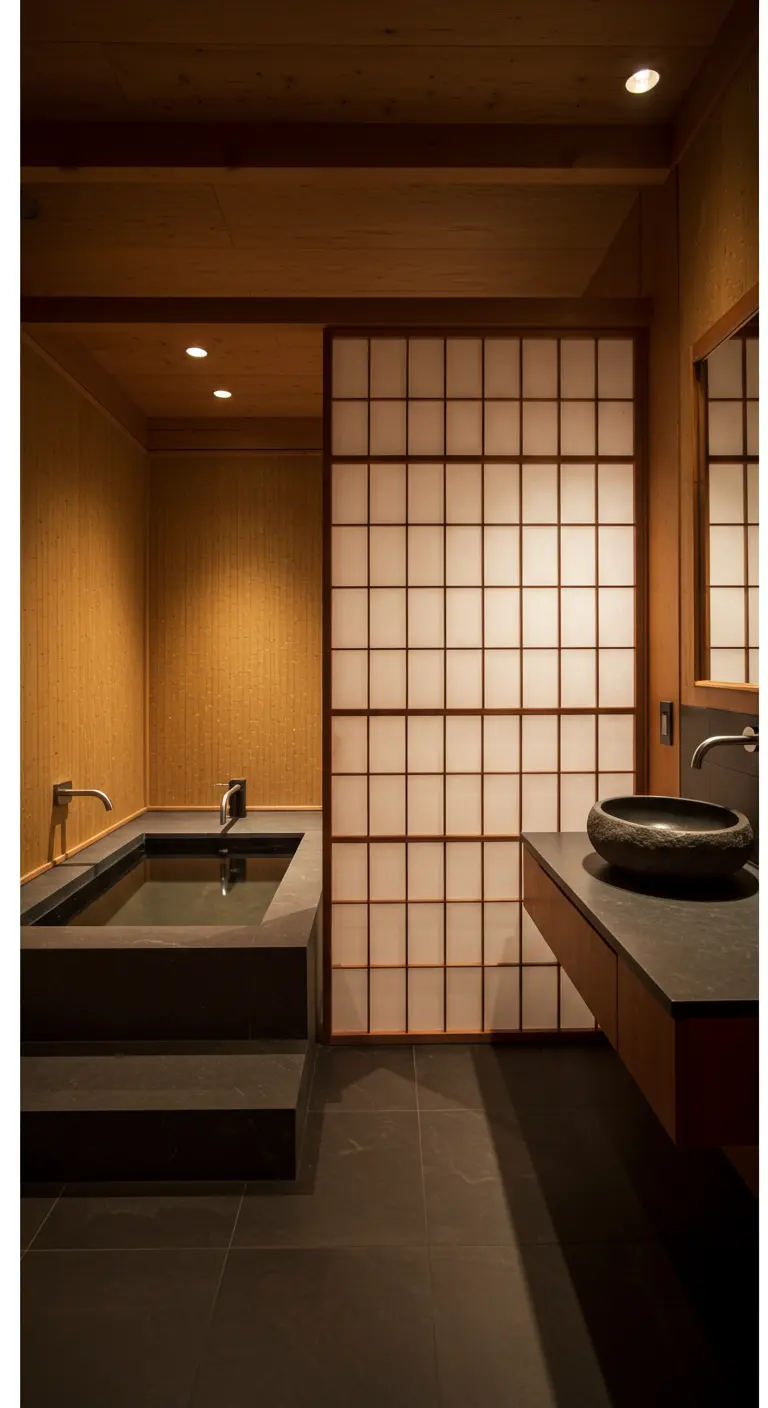
Use a traditional Japanese Shoji screen to masterfully divide a space while allowing light to pass through.
The translucent paper diffuses light beautifully, casting a soft, even glow that eliminates harsh shadows and creates an instant sense of serenity.
Use one as a sliding door, a room divider, or a window covering.
The clean, geometric grid of the wooden frame is a classic architectural element that complements the simple forms of a sunken tub or minimalist vanity.
19. The Bathroom as a Garden Pavilion
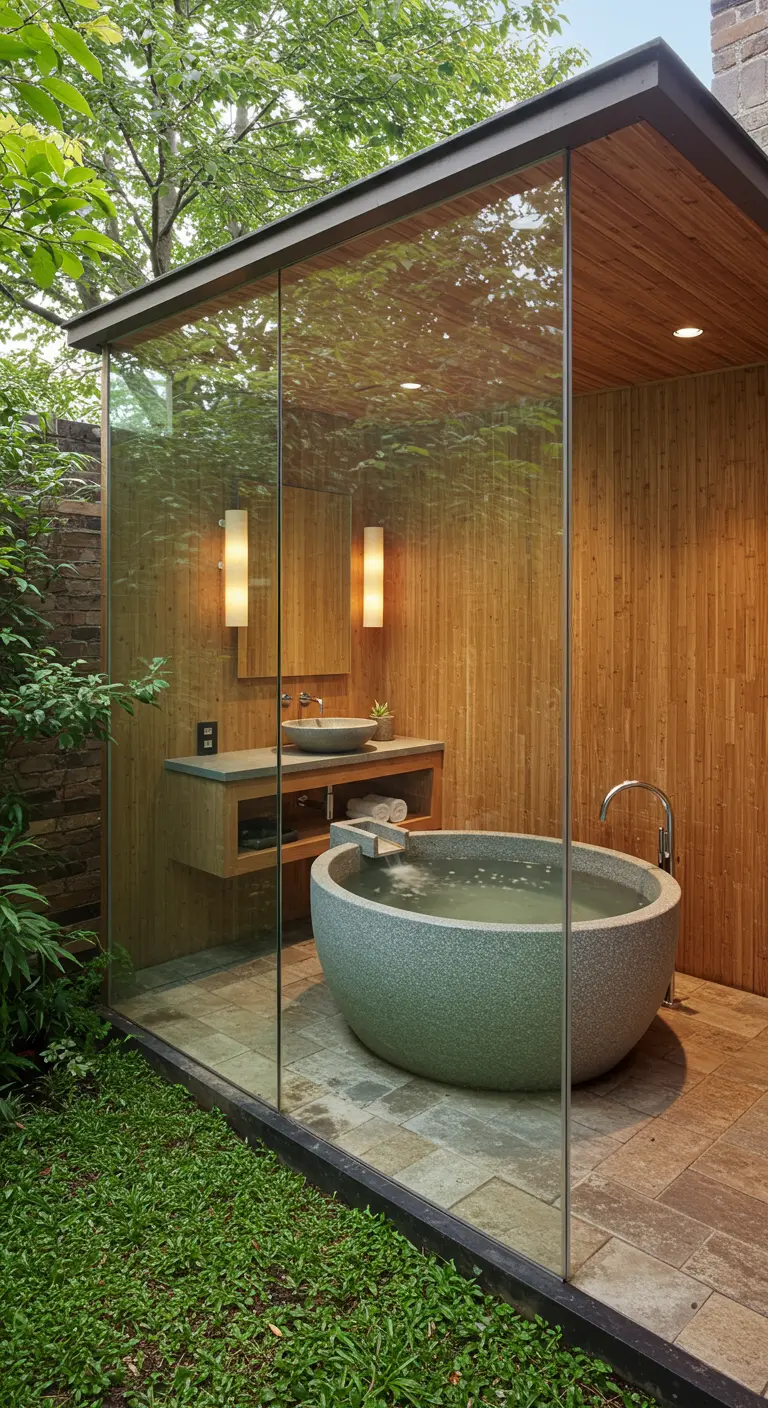
For the ultimate immersion in nature, envision your bathroom as a standalone glass pavilion set within a garden.
Floor-to-ceiling glass on all sides dissolves the typical boundaries of a room, making the surrounding greenery the primary decorative element.
Privacy is key, so this design works best when oriented towards a secluded courtyard or a dense patch of trees.
Keep the interior materials simple and natural—light wood, stone—to ensure the focus remains firmly on the breathtaking view.
20. The Earthy Warmth of Terracotta and Wood

Create an undeniably inviting and grounded atmosphere by pairing warm-toned wood with earthy terracotta tiles.
The reddish-brown hues of the terracotta floor create a harmonious and comforting color story when combined with honey-colored wood on the tub and walls.
This palette feels timeless and deeply connected to nature.
A simple square tile pattern adds subtle geometry that grounds the space without competing with the warmth of the materials.
21. High-Contrast, Textural Minimalism
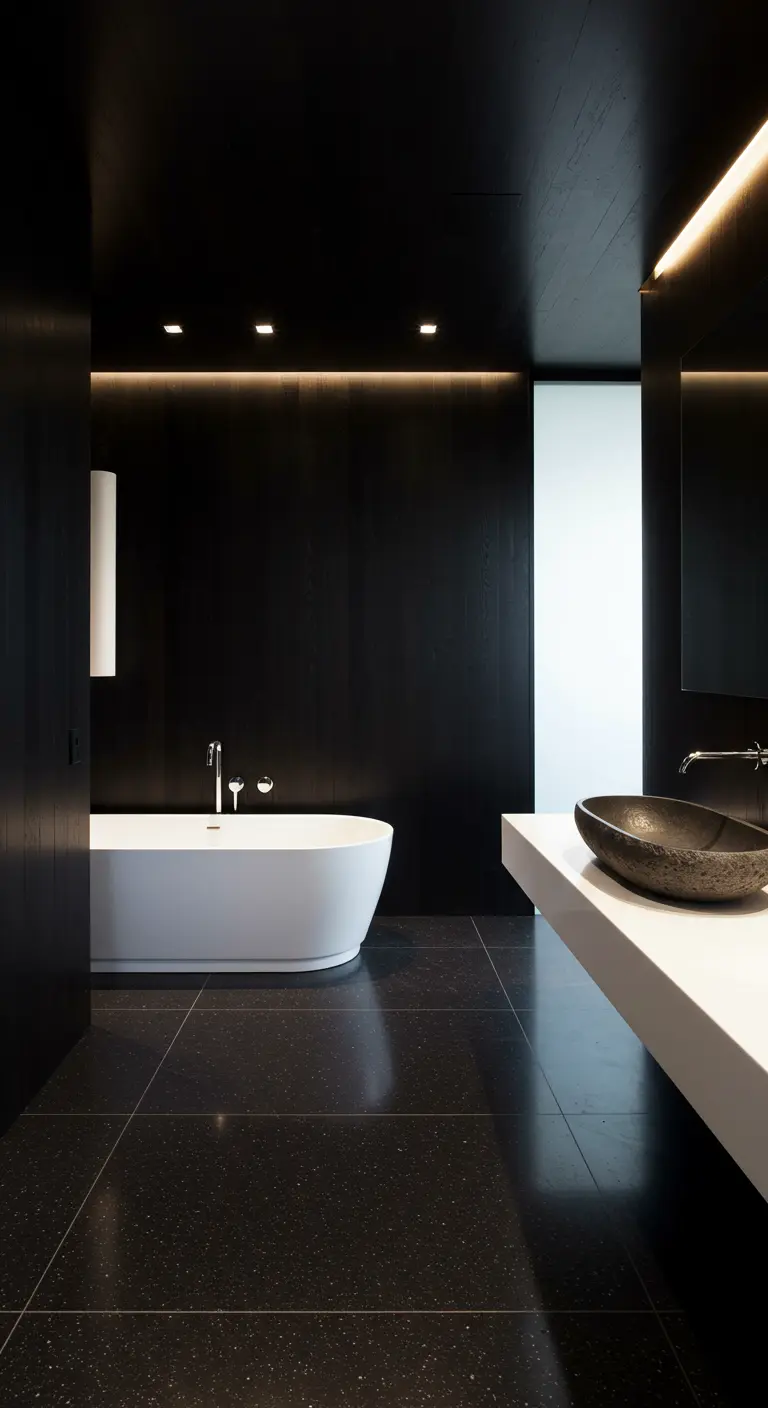
Create a bold and modern statement with a strictly black-and-white palette.
The secret to making this work is a focus on texture and light. Matte black walls provide a soft, velvety backdrop for the sculptural form of a glossy white tub.
A speckled terrazzo floor adds a subtle pattern that artfully ties the black and white elements together.
Integrated cove lighting prevents the dark walls from feeling oppressive and turns the simple space into an architectural composition.
22. Create a Treetop Bathing Nook
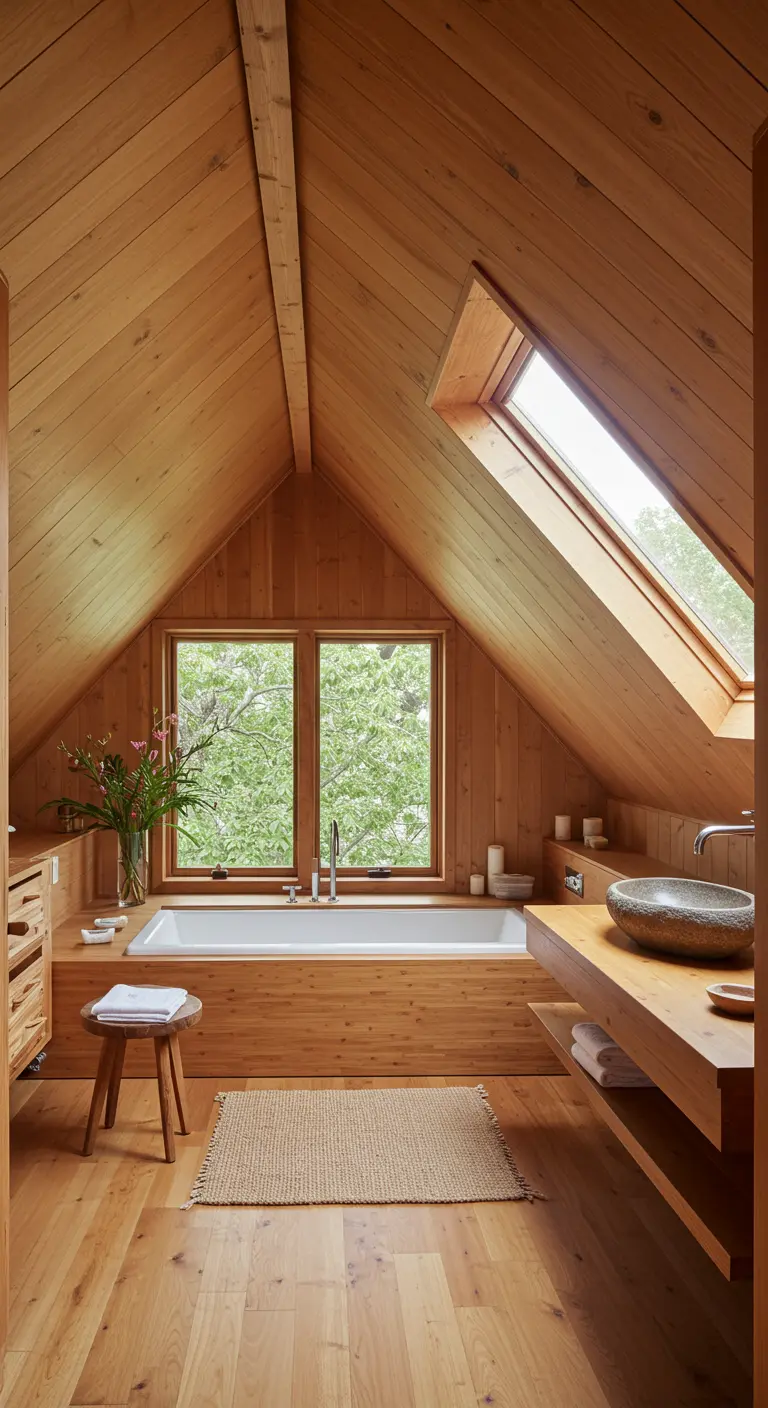
Turn an often-awkward attic space into a charming, light-filled retreat.
Cladding the slanted ceilings and walls in the same light wood creates a unified feel and makes the room feel more expansive.
Position the tub directly beneath the windows to take full advantage of the view, creating the feeling of bathing among the treetops.
A low, built-in tub surround accommodates the lower ceiling height, while a simple jute rug adds a welcome layer of soft, natural texture.
23. Add the Soothing Sound of Moving Water
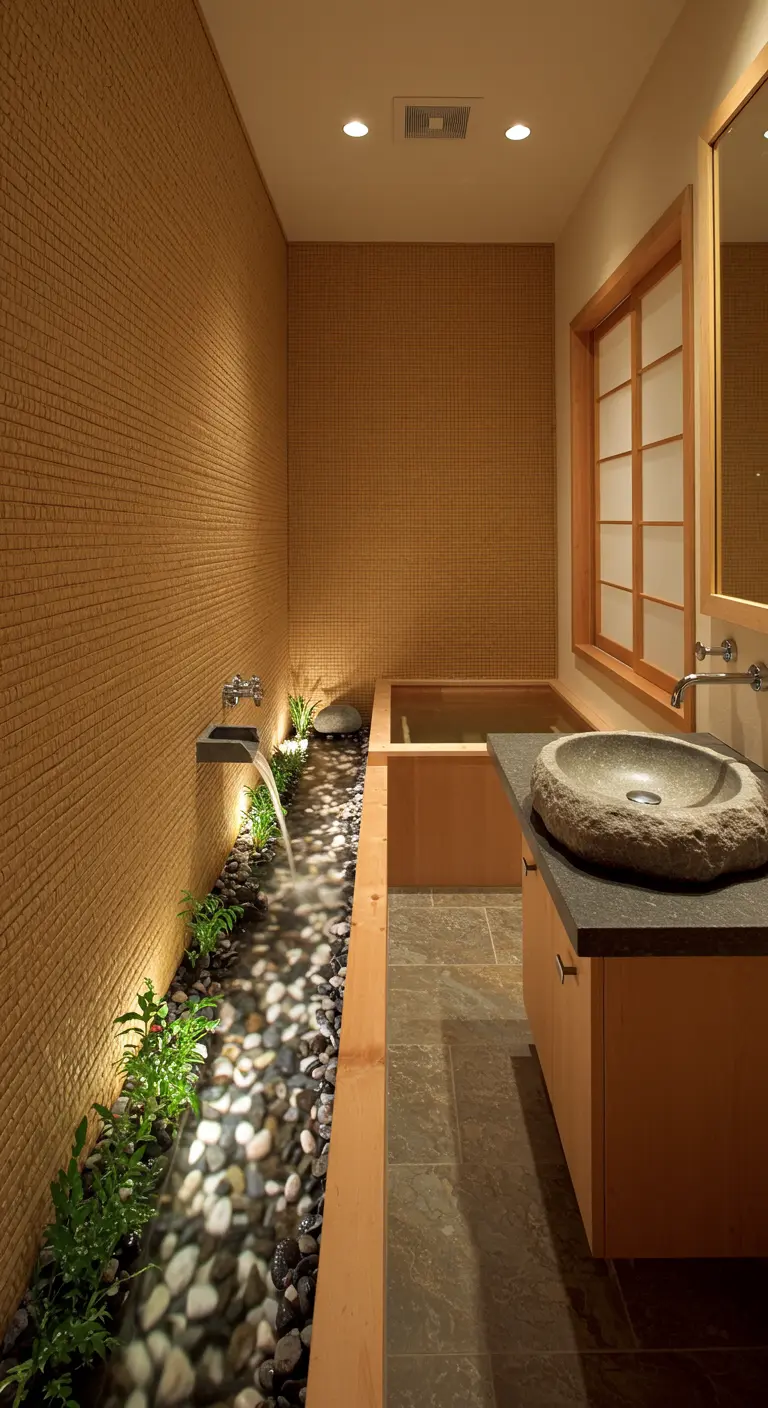
Elevate your bathing ritual from a visual experience to a multi-sensory one by incorporating the sound of flowing water.
A shallow, waterproof channel running alongside the tub, filled with river rocks and small plants, can create your own miniature babbling brook.
A simple wall-mounted spout provides the gentle, meditative sound of a waterfall.
This unique feature transforms a bathroom into a true spa-like retreat, engaging your sense of hearing for deeper relaxation.
24. Design with Integrated Architectural Lighting

Move beyond standard fixtures and build lighting directly into your bathroom’s architecture for a clean, seamless, and high-end look.
Recessed vertical LED strips create pillars of light that add rhythm and drama to the walls.
A lit niche above the tub offers soft, ambient light and a beautiful display area for bathing essentials.
This approach keeps surfaces uncluttered and allows the quality of the light itself to become a primary design element.
25. The Luxurious Open-Concept Suite
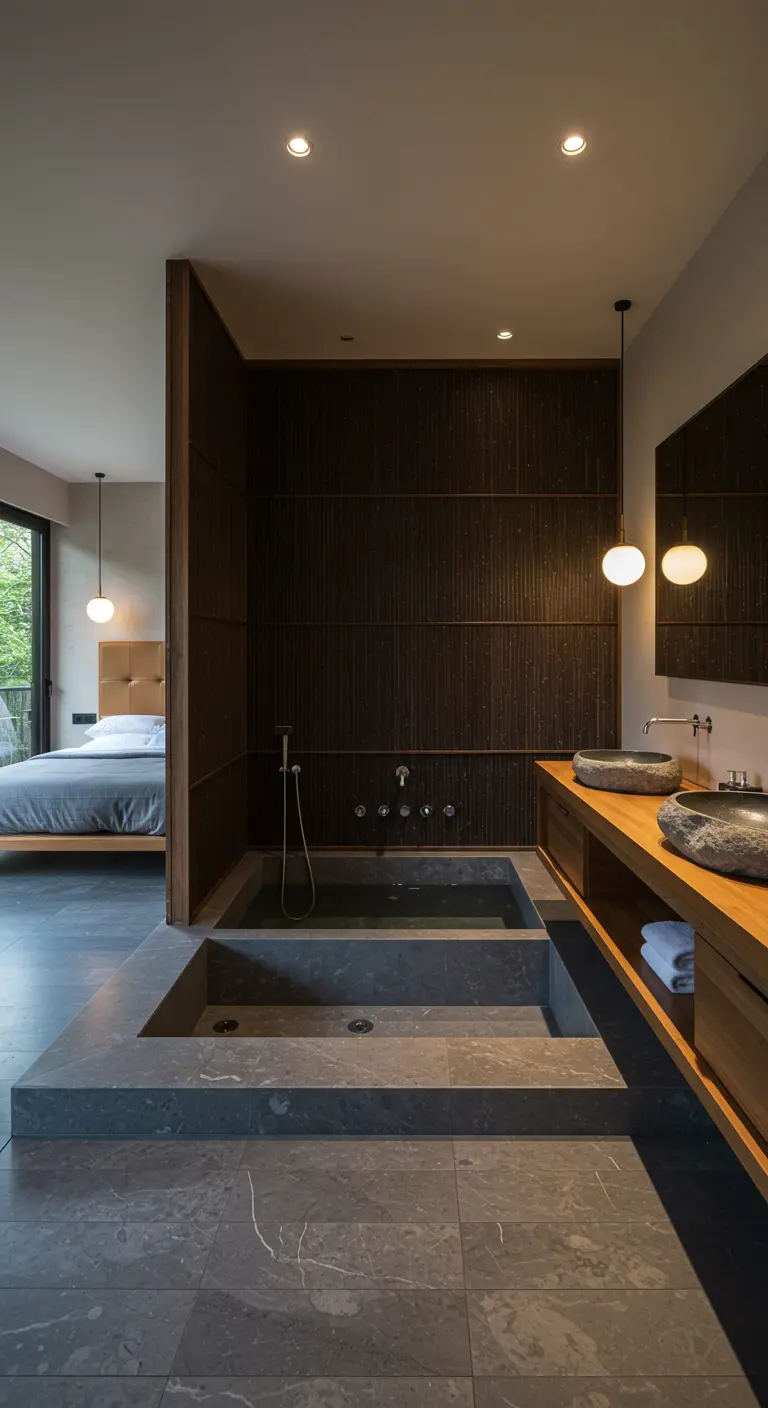
Create a spacious, hotel-inspired feel by opening the bathroom to the primary bedroom.
A partial wall or a decorative screen, like this dark slatted wood partition, provides a sense of separation while maintaining an open, airy connection.
The sunken, multi-level stone tub becomes a stunning architectural feature for the entire suite, not just the bathroom.
Using the same flooring material throughout both spaces is key to creating a unified, expansive flow.
26. The Calming Power of Perfect Symmetry

Establish an immediate sense of calm, order, and elegance with a symmetrical layout.
Center the design around a strong focal point, like this sunken tub and the large picture window behind it.
Arrange identical elements on either side—here, two matching vanities with the same sinks, mirrors, and lighting.
This balanced approach is inherently pleasing and restful to the eye, creating a feeling of classical harmony and profound tranquility.
27. Industrial Materials, Zen Sensibility

Combine the raw, honest materials of industrial design with the uncluttered principles of Zen for a unique, sophisticated look.
Smooth, poured concrete walls provide a cool, minimalist backdrop that contrasts beautifully with a warm, dark wood accent wall.
A sleek stainless steel tub reinforces the industrial edge, while its simple form maintains the serene feeling.
This aesthetic embraces contemporary industrial style with a much more refined, tranquil approach.
28. Wrap Your Walls in Woven Texture

For ultimate warmth and tactile interest, envelop a small bathroom in a woven wall covering like bamboo, rattan, or grasscloth.
This adds a hand-crafted, organic texture that is much more impactful than a simple coat of paint.
The subtle pattern and natural material create a cozy, cocoon-like feeling that is perfect for a small, intimate space.
Pair it with other natural elements like a wooden tub and irregular flagstone floors to complete the rustic, immersive experience.
29. The Tiered Tub as a Grand Centerpiece
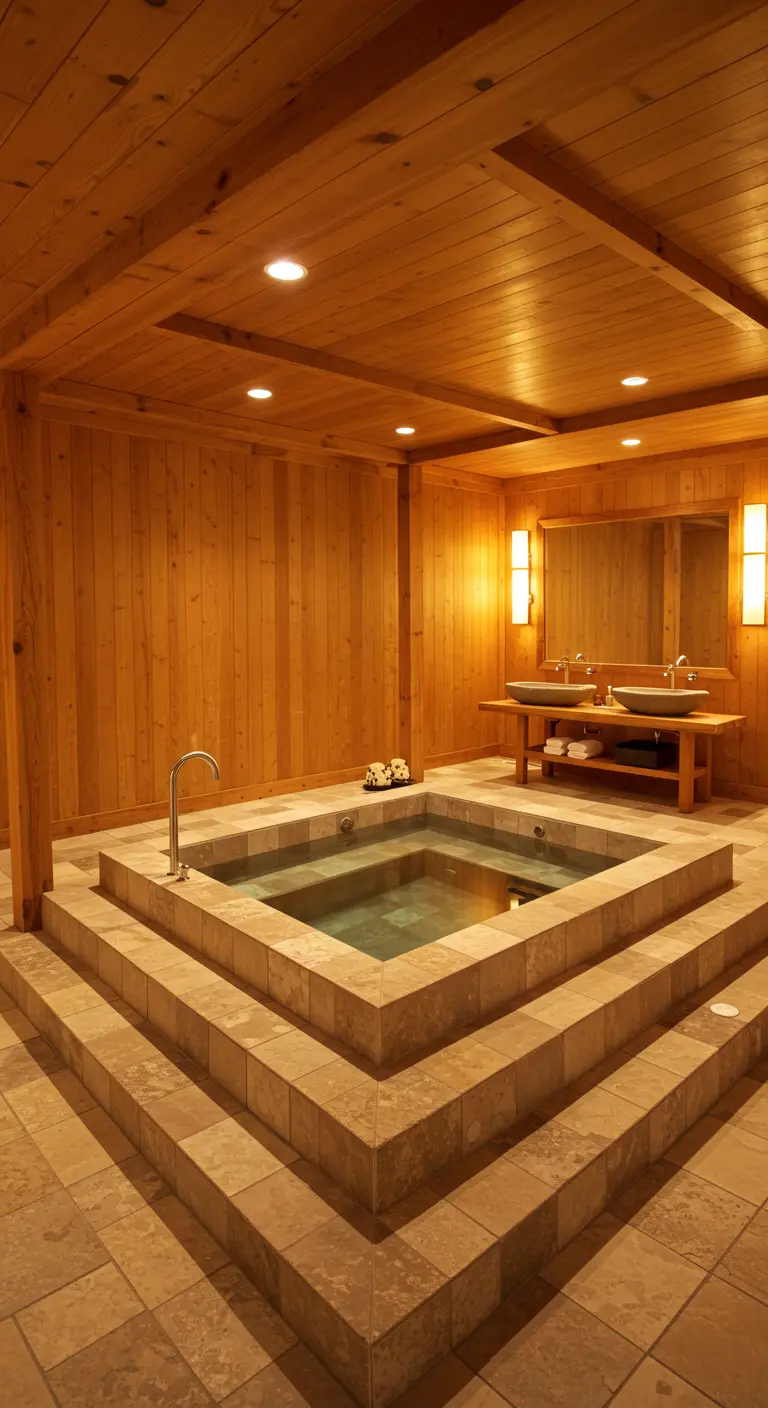
Transform the simple act of bathing into a grand ritual by designing a multi-tiered, sunken tub.
Constructed like ancient Roman baths, the wide, tiled steps provide places to sit and relax, making the tub a luxurious architectural feature.
This impressive design requires significant space but delivers an unparalleled, spa-like experience at home.
A coffered wood ceiling and warm, thoughtful lighting enhance the sense of scale and intimacy.
30. Introduce Glamour with Metallic Inlays
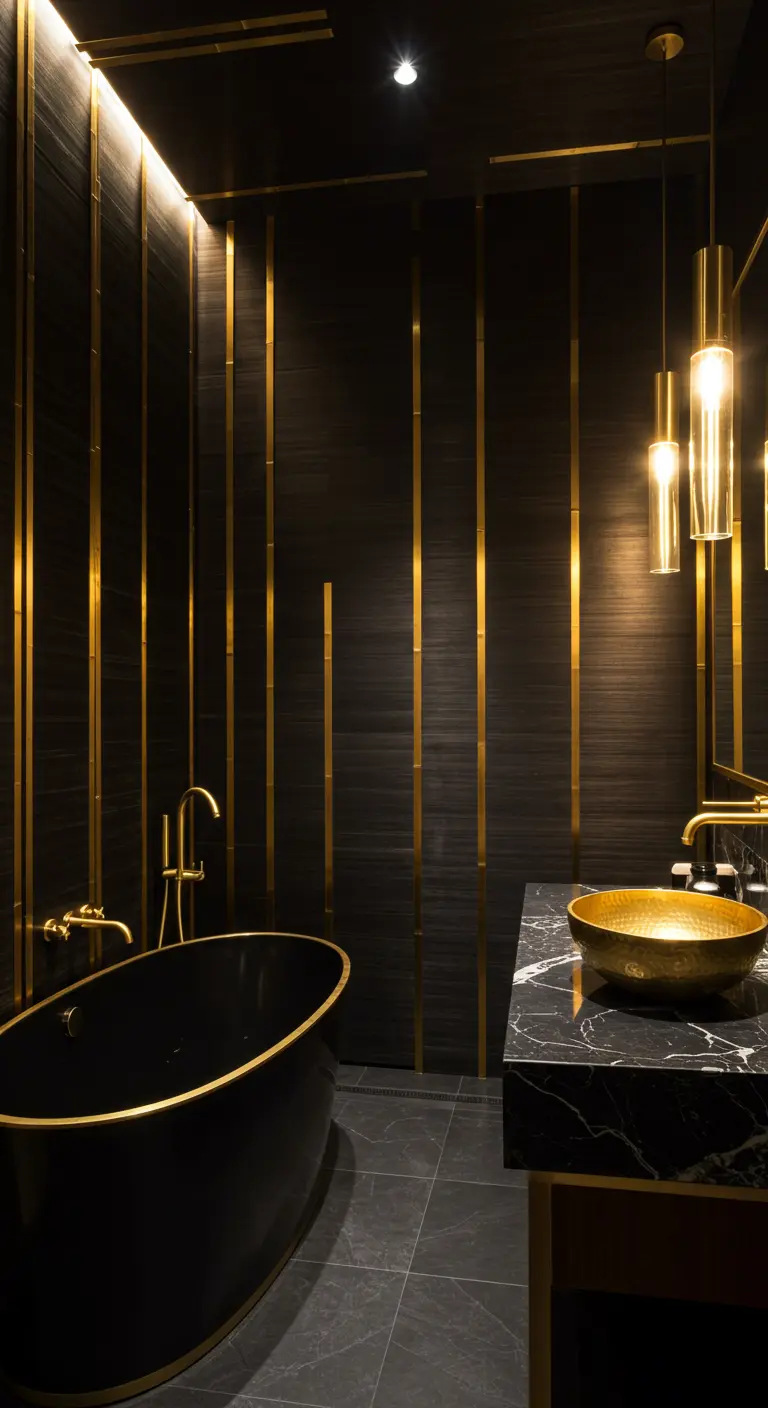
Add a touch of Art Deco-inspired luxury to a dark bathroom with thoughtfully placed metallic details.
Instead of confining gold or brass to fixtures, integrate thin metal strips directly into the wall paneling for a sophisticated, linear design.
This technique catches the light beautifully and adds a layer of unexpected glamour.
Echo the metal in the fixtures and basin for a cohesive and opulent look that feels both modern and timeless, recalling the elegance of glamorous Hollywood-style bathrooms.
